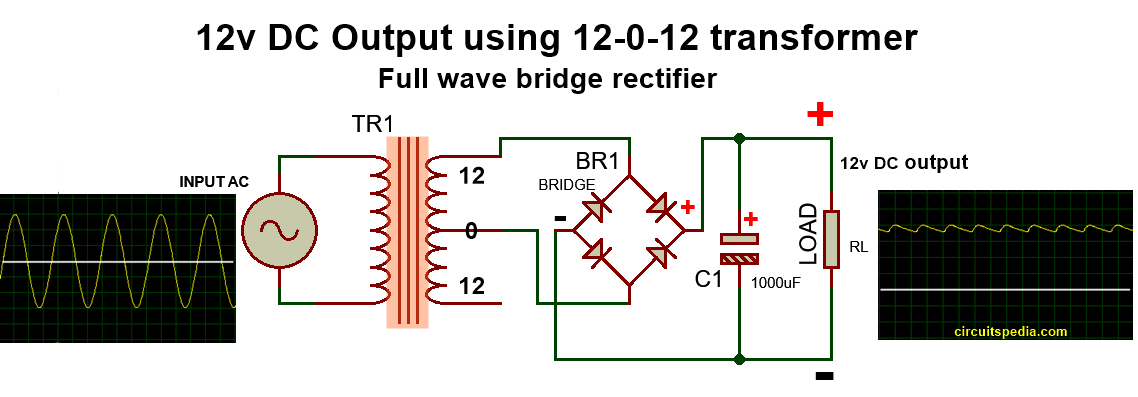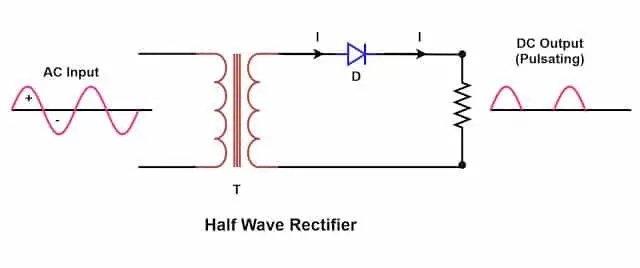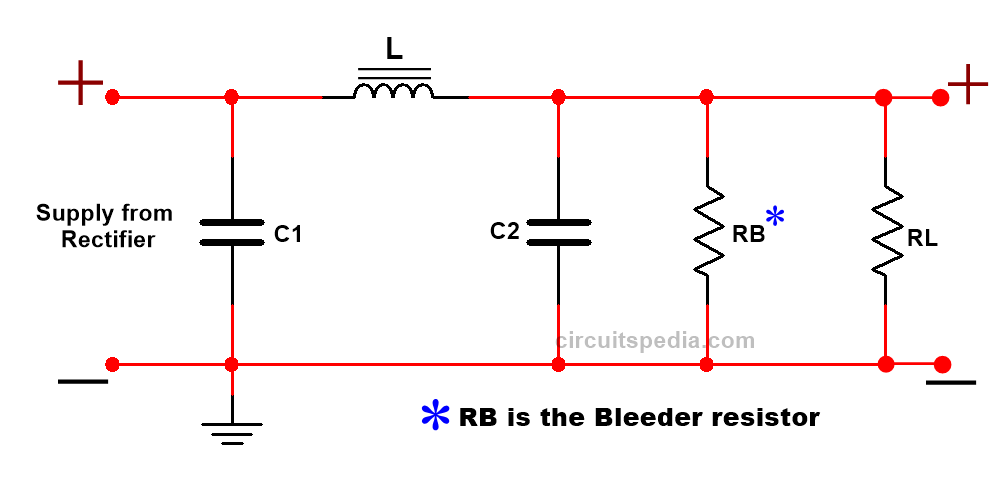Contents
- Introduction
- 1. Center-Tapped Full-Wave Rectifier
- Peak inverse voltage
- 2. Bridge Rectifier/Full wave bridge rectifier
- What is Ripple in rectifier output
- Other Types of Full-Wave Rectifiers
- Applications of Full-Wave Rectifiers
- Simulation video of Full wave rectifier in Multisim
- Advantages and disadvantages of a full-wave rectifier
Introduction
In power electronics, rectifiers are essential components that convert alternating current (AC) into direct current (DC). Among the various types of rectifiers, full-wave rectifiers are widely used due to their efficiency and ability to utilize both the positive and negative halves of the input AC signal. In this article, we will discuss the working principle, types, and applications of the full-wave rectifier, uncovering their significance in numerous electronic devices.
Full-wave rectifiers are electronic circuits designed to convert AC voltage into pulsating DC voltage. They achieve this by utilizing diodes, which allow current to flow in one direction while blocking the reverse flow. Full-wave rectifiers have two popular configurations: the center-tapped full-wave rectifier and the bridge rectifier.
1. Center-Tapped Full-Wave Rectifier
This configuration employs a center-tapped transformer and two diodes. The center tap acts as a reference point, connecting the secondary coil of the transformer to the ground.
Working of Center-Tapped Full-Wave Rectifier
- This type of rectifier uses a center-tapped transformer and two diodes.
- The center tap of the secondary winding of the transformer is connected to the ground or reference point.
- During the positive half-cycle of the input alternating current (AC) voltage, one of the diodes becomes forward-biased and conducts, allowing current to flow through it.
- Simultaneously, the other diode becomes reverse-biased and blocks the current flow.
- As a result, current flows through one-half of the secondary winding and charges the positive terminal of the load, producing a positive half-cycle output.
- During the negative half-cycle of the input AC voltage, the polarities across the diodes are reversed, and the conducting and blocking roles switch between the two diodes.
- The current flows through the other half of the secondary winding and charges the negative terminal of the load, producing a negative half-cycle output.
- The output is a pulsating direct current (DC) waveform that consists of both positive and negative half-cycles.
Peak inverse voltage
It is the maximum voltage that the rectifying diode has to withstand when it is reverse-biased. The peak inverse voltage(PIV) rating of a diode is of primary importance in the design of rectification systems. Peak inverse voltage is the maximum possible voltage across a diode when it is reverse-biased. During the first half cycle of the supply i.e. When the top of the transformer secondary winding is positive, diode D1 conducts and offers almost zero resistance. So whole of the voltage VSmax of the upper half winding is developed across the load resistance RL. Now voltage across the non-conducting diode D2 is the sum of the voltage across the lower half of the transformer secondary and type voltage across the load resistance RL.
Thus PIV of the diode, D2 = VSmax+VSmax = 2VSmax
Similarly PIV of diode D1 = 2VSmax
2. Bridge Rectifier/Full wave bridge rectifier
The bridge rectifier configuration is more common and efficient, utilizing four diodes arranged in a bridge configuration. It eliminates the need for a center-tapped transformer.
Working of Bridge rectifier/bridge full wave rectifier working
- The bridge rectifier configuration utilizes four diodes arranged in a bridge or diamond configuration.
- It does not require a center-tapped transformer.
- The input AC voltage is applied across two opposite corners of the bridge, while the load is connected to the remaining two corners.
- During the positive half-cycle of the input AC voltage, two diodes become forward-biased and allow current to flow through them.
- Simultaneously, the other two diodes become reverse-biased and block the current flow.
- The current flows through the forward-biased diodes and charges the positive terminal of the load, resulting in a positive half-cycle output.
- During the negative half-cycle of the input AC voltage, the polarities across the diodes are reversed, and the forward-biased and reverse-biased roles switch between the diodes.
- The current flows through the newly forward-biased diodes and charges the negative terminal of the load, producing a negative half-cycle output.
- Similar to the center-tapped rectifier, the output of the bridge rectifier is a pulsating DC waveform that consists of positive and negative half-cycles
Working of full wave bridge rectifier with capacitor filter
What is Ripple in rectifier output
Ripple in rectifiers refers to the residual alternating current (AC) component present in the output of a rectifier circuit, which is intended to produce direct current (DC) output. It is a fluctuation or variation in the DC voltage or current level.
In ideal rectifiers, the output would be a pure DC waveform with a constant voltage or current level. However, due to the imperfect nature of rectifier circuits, some inherent limitations and non-idealities result in the presence of ripple.
The ripple occurs because the rectifier circuit is not able to eliminate the alternating component of the input AC waveform.
Ripple factor
The ripple factor is defined as the ratio of the effective value of the AC components of voltage or current present in the output from the rectifier to the direct or average value of the output voltage or current. It is an indication of how successful is a circuit in converting AC to DC.
The ripple factor for the half wave is 1.21 whereas for full weave rectifier is 0.482
How to Remove Ripple from Rectifier Output
The most commonly used component for removing the ripple is a capacitor. Here are the steps to remove ripple from a rectifier output:
- Choose the Capacitor Value: The capacitance value of the capacitor used for filtering is crucial in determining the level of ripple reduction. Higher capacitance values result in better ripple suppression. The appropriate capacitor value can be calculated based on the desired ripple level and the load characteristics.
- Connect the Capacitor in Parallel: Connect the capacitor in parallel with the load across the rectifier output. The positive terminal of the capacitor should be connected to the positive terminal of the rectifier output, and the negative terminal of the capacitor should be connected to the negative terminal of the rectifier output.
The PIV of a bridge rectifier circuit PIV= VSmax
It’s important to note that while the capacitor significantly reduces ripple, it does not eliminate it. Some residual ripple will still be present, determined by the capacitance value and load characteristics. To further reduce ripple, additional filtering components such as inductors or voltage regulators can be used.
Rectification efficiency
Rectification efficiency is defined as the ratio of DC output power to the AC input power from the transformer secondary (i.e. η=Pdc/Pac) and is a figure of merit to compare rectifiers.
Rectification Efficiency is 40.6% in the case of half-wave rectifiers and 81.2% in the case of full-wave rectifiers.
Transformer utilization factor (TUF)
is defined as the ratio of power delivered to the load and ac rating of the transformer secondary.
i.e. TUF = Pdc/Pac(rated)= I2dcRL/VSrmsIrms
It is used to determination of the necessary rating of a transformer for a given dc load. TUF for half wave is 0.286, for center-tap is 0.692, and for bridge rectifiers is 0.812
Other Types of Full-Wave Rectifiers
Full-wave rectifiers can be further classified based on the type of diodes used. The two most commonly used diodes are:
- Silicon Diode Full-Wave Rectifiers: Silicon diodes are widely employed in full-wave rectifier circuits due to their low forward voltage drop and high current-carrying capacity. They offer efficiency and cost-effectiveness, making them suitable for most applications.
- Schottky Diode Full-Wave Rectifiers: Schottky diodes are known for their extremely low forward voltage drop, resulting in lower power losses and increased efficiency. They find applications in high-frequency scenarios and situations where low voltage drop is crucial.
Applications of Full-Wave Rectifiers
Full-wave rectifiers have diverse applications in numerous electronic devices and industries:
- Power Supplies: Full-wave rectifiers are essential components in power supply units used in electronic devices such as televisions, computers, audio systems, and home appliances. They convert the alternating current (AC) from the mains into the direct current (DC) that is required to power these devices.
- Battery Charging: Full-wave rectifiers are commonly used in battery charging circuits to convert AC voltage from a wall socket into DC voltage suitable for charging batteries efficiently. They ensure a smooth and constant DC voltage supply to the battery, allowing for effective and safe charging.
- Motor Control: In motor control circuits, full-wave rectifiers are employed to convert AC power into DC power. This is crucial for controlling the speed and direction of motors in various applications, such as industrial machinery, robotics, and electric vehicles. Full-wave rectifiers provide the necessary voltage and current required for effective motor control.
- LED Lighting: Full-wave rectifiers play a vital role in converting AC voltage into DC voltage for powering Light Emitting Diodes (LEDs). LED lighting systems require a stable and regulated DC voltage supply to ensure optimal performance and longevity of the LEDs. Full-wave rectifiers enable efficient and controlled lighting solutions by converting the AC power source into a suitable DC voltage for driving the LEDs.
- Audio Amplifiers: Full-wave rectifiers are used in audio amplifier circuits to convert the AC audio signals into a rectified DC voltage. This rectified DC voltage is further filtered and smoothed to provide a stable power supply for the amplifier, enabling the amplification of audio signals with minimal distortion.
- Frequency Multipliers: Full-wave rectifiers can be utilized in frequency multiplier circuits. By rectifying and filtering an AC input signal, the full-wave rectifier can generate an output signal with a frequency that is a multiple of the input frequency. This is commonly used in radio frequency (RF) and wireless communication systems.
- Welding Equipment: Full-wave rectifiers are employed in welding machines to convert the AC input power into DC power for welding operations. The rectified and filtered DC output provides a stable and controlled current flow required for welding processes, ensuring strong and reliable welds.
- Uninterruptible Power Supplies (UPS): Full-wave rectifiers are utilized in UPS systems to convert AC power from the mains into DC power for charging the backup batteries. In case of a power outage, the stored DC power is converted back to AC power through an inverter, providing an uninterrupted power supply to critical equipment or systems.
Simulation video of Full wave rectifier in Multisim
Advantages and disadvantages of a full-wave rectifier
Advantages
- Higher efficiency: Compared to half-wave rectifiers, full-wave rectifiers have higher efficiency because they utilize both halves of the AC waveform, resulting in more effective utilization of power.
- Higher output voltage: Full-wave rectifiers produce a higher average output voltage compared to half-wave rectifiers. This is advantageous when a higher DC voltage is required for powering electronic devices.
- Smoother output: The output of a full-wave rectifier has less ripple (AC component) compared to a half-wave rectifier, resulting in a smoother DC output voltage. This is beneficial for applications that require a steady and stable DC voltage, such as electronic devices and power supplies.
- Lower transformer utilization factor (TUF): Full-wave rectifiers have a TUF of 0.8125, which is higher than the TUF of 0.287 for half-wave rectifiers. This means that full-wave rectifiers require a smaller transformer, reducing cost and size.
Disadvantages
- Complex circuitry: Full-wave rectifiers typically require more components and a more complex circuit configuration compared to half-wave rectifiers, which can make them more expensive and difficult to design and implement.
- Higher cost: Due to the increased number of components required, full-wave rectifiers can be more expensive to manufacture than half-wave rectifiers.
- Higher heat dissipation: Full-wave rectifiers tend to generate more heat due to the use of multiple diodes and transformers, which can require additional heat dissipation mechanisms or cooling systems.
- Increased complexity in voltage regulation: If voltage regulation is required, maintaining a constant output voltage in a full-wave rectifier can be more challenging and complex compared to a half-wave rectifier.









Hello
I need to